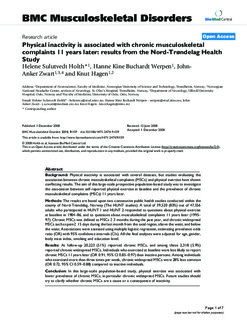| dc.description.abstract | Background: Physical inactivity is associated with several diseases, but studies evaluating the
association between chronic musculoskeletal complaints (MSCs) and physical exercise have shown
conflicting results. The aim of this large-scale prospective population-based study was to investigate
the association between self-reported physical exercise at baseline and the prevalence of chronic
musculoskeletal complaints (MSCs) 11 years later.
Methods: The results are based upon two consecutive public health studies conducted within the
county of Nord-Trøndelag, Norway (The HUNT studies). A total of 39,520 (83%) out of 47,556
adults who participated in HUNT 1 and HUNT 2 responded to questions about physical exercise
at baseline in 1984–86, and to questions about musculoskeletal complaints 11 years later (1995–
97). Chronic MSCs was defined as MSCs ≥ 3 months during the past year, and chronic widespread
MSCs such as pain ≥ 15 days during the last month from the axial region, above the waist, and below
the waist. Associations were assessed using multiple logistic regression, estimating prevalence odds
ratio (OR) with 95% confidence intervals (CIs). All the final analyses were adjusted for age, gender,
body mass index, smoking and education level.
Results: At follow-up 20,223 (51%) reported chronic MSCs, and among these 2,318 (5.9%)
reported chronic widespread MSCs. Individuals who exercised at baseline were less likely to report
chronic MSCs 11 years later (OR 0.91, 95% CI 0.85–0.97) than inactive persons. Among individuals
who exercised more than three times per week, chronic widespread MSCs were 28% less common
(OR 0.72, 95% CI 0.59–0.88) compared to inactive individuals.
Conclusion: In this large-scale population-based study, physical exercise was associated with
lower prevalence of chronic MSCs, in particular chronic widespread MSCs. Future studies should
try to clarify whether chronic MSCs are a cause or a consequence of inactivity. | nb_NO |

